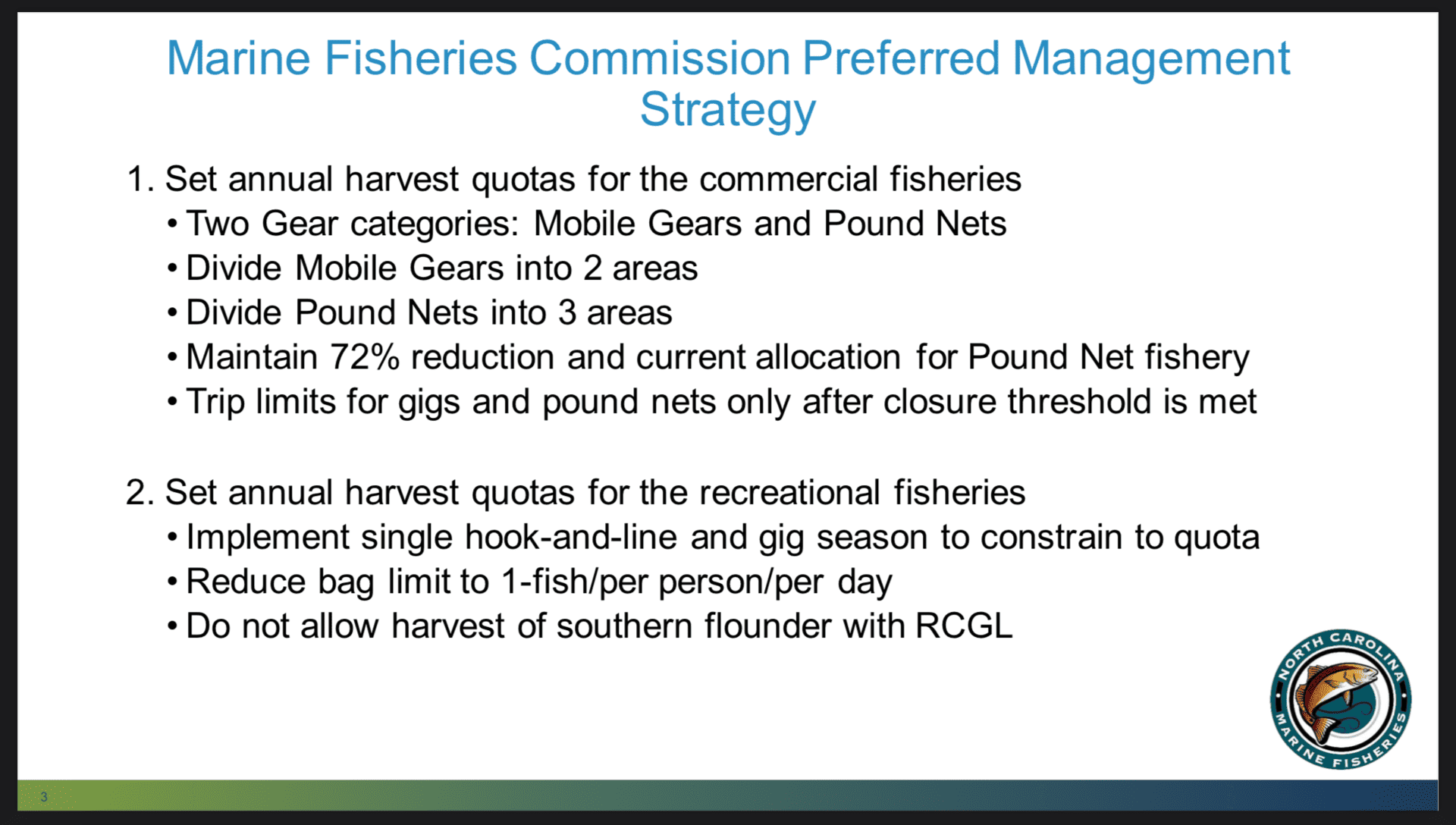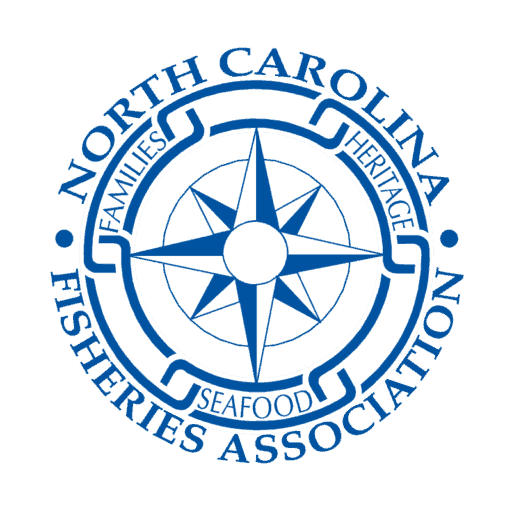More Flounder Mismanagement
In the Weekly Update last week, I talked about how the North Carolina Division of Marine Fisheries (DMF) has gone outside of the southern flounder FMP (fisheries management plan) and decided to set their own rules for the 2023 commercial flounder season. This week, I am going to let DMF tell you. Let us look at what management measures were presented by DMF and chosen by the Marine Fisheries Commission (MFC) in regards to setting commercial flounder regulations.
First of all, the number of days allowed per week to use large mesh gill nets was set to minimize protected species (sea turtles and sturgeon) interactions. In 2013 DMF recommended and the MFC adopted into Amendment 1 to the southern flounder FMP,
“To allow the large mesh gill net management measures from the sea turtle law suit settlement agreement…. [and] limit the use of large mesh gill nets (4-6-1/2-inch stretched mesh) to four nights per week, Monday through Thursday, except allow an extra day (Sunday/Monday) for setting large mesh gill nets south of Beaufort Inlet.”
Allowed days of the week and all other large mesh gill net restrictions have since been carried over through each amendment process including Amendment 3.
Secondly, during both the February 2022 and May 2022 MFC meetings, DMF staff clearly said, explained, and showed that, “The Division will have the ability to set trip limits for either pound nets and the gig fishery only after meeting closure thresholds.”


Audio 1
Audio 2
Adaptive management (Appendix 4.4 of Amendment 3) gives the DMF Director, “management framework that allows for specific management changes to be implemented between FMP reviews under specified conditions to accomplish the goals and objectives of the plan.”
“Adaptive management, will be implemented through the use of proclamation authority allowing the Fisheries Director to:
-Determine opening dates for commercial seasons bases on measures selected through the Achieving Sustainable Harvest issue paper.
-Close the commercial fishery based on quota monitoring data to maintain harvest levels at or below the TAL, including closure when the majority of harvest has occurred (typically about 80% of the quota allocation, but it can be more or less)
-Develop and implement commercial trip limits to maximize the harvest and minimize the risk of exceeding the quota during the open season.
-Select recreational season dates for the hook-and-line and gig fisheries.
-Implement and alter bag limits for the recreational fishery.
-Implement and alter vessel limits for the recreational fishery.
-Change the recreational southern flounder season based on harvest of southern flounder that occurs during the ocellated season.
-Cancel the early recreational ocellated season if it is necessary to prevent exceeding the TAL for the recreational southern flounder fishery.
-Apply accountability measures for both the commercial and recreational fisheries.
No where in the adaptive management does it mention reducing the number of days allowed to use large mesh gill nets and although trip limits are mentioned here, Amendment 3 states NINE TIMES, (pages 45, 80, 85, 92, 96, 98, 127, 128, and 163) that trip limits will only be used after reopening once closure thresholds have been met.
NCFA Executive Director, Glenn Skinner sent an email to DMF Director Kathy Rawls on August 16th about these issues. The verbal response from DMF was that their attorney felt they were on firm legal ground with the proclamation they had issued and Director Rawls moved forward despite our concerns. If you or anyone you know has concerns with the pound net trip limits or the 3-day large mesh gill net restriction please contact Director Rawls at 252-808-8013.
Director Rawls,
After reading the proclamation setting the commercial Southern Flounder seasons, it appears that the Division has, once again, exceeded its authority to manage the Southern Flounder fishery. When I say “once again”, I’m referring to the issue we brought to your attention, this past February, regarding DMF’s attempt to deduct pound net harvest overages, in 2022, from the Central and Southern Areas 2023 quota, despite the sector as a whole coming in well below their 2022 TAL. As we pointed out at the time, these actions were contrary to the language adopted by the MFC, through Amendment 3, which states that “For the commercial fishery, if the combined TAL for all gear and area combinations are not exceeded at the end of the fishing year, accountability measures will not be applied.” After our inquiry, DMF acknowledged that we were correct in our interpretation of Amendment 3, and the Division’s authority to apply accountability measures.
We feel that a similar situation has occurred when the Division set trip limits for the Northern, Central, and Southern Areas pound net fisheries and limited the use of large mesh gill nets to only three days a week (Tuesday-Thursday).
Trip Limits
On page 127, of Amendment 3 it states that, “Amendment 3 proposes modifying the commercial seasons to maintain a quota with allocations based on gear and area; modifying the recreational season with quota allocations to the hook-and-line and gig fisheries; implementing and altering recreational bag limits; and implementing commercial trip limits and recreational vessel limits. Upon adoption of Amendment 3, management strategies approved in Amendment 3, will be implemented through use of proclamation authority allowing the Fisheries Director to:
* Determine opening dates for commercial seasons based on measures selected through the Sustainable Harvest Issue Paper
* Close the commercial fishery based on quota monitoring data to maintain harvest levels at or below the TAL, including closure when a majority of harvest has occurred (typically 80% of the quota allocation, but it can be more or less)
* Develop and implement commercial trip limits to maximize the harvest and minimize the risk of exceeding the quota during the open season
*Select recreational season dates for the hook-and-line and gig fisheries
*Implement and alter bag limits for the recreational fishery
*Change the recreational Southern Flounder season based on harvest of Southern Flounder that occurs in the ocellated season
*Cancel the early recreational ocellated season if it is necessary to prevent exceeding the TAL for the recreational Southern Flounder fishery
*Apply accountability measures for both the commercial and recreational fisheries”
While it’s clear that the Director has authority to “set trip limits”, it’s also clear that this authority is limited to situations where the Divisions closure threshold has been met and a re-opening is deemed possible based on how much quota remains. This is evident in the language above which states the purpose of implementing a trip limit is “to maximize harvest and minimize the risk of exceeding the quota”. The term “maximize harvest” refers to the traditional use of trip limits to allow the maximum amount of harvest to be achieved, after the closure threshold has been met, while ,at the same time, minimizing the risk of exceeding the TAL.
This conclusion is reinforced on page 45 of Amendment 3, under the heading “Southern Flounder Amendment 3 Management Strategy” which states “The NCMFC selected the following management options: 5. Implement trip limits for pound nets and gigs only to maximize re-opening after reaching Division closure threshold”
and,
on page 125 of Amendment 3, under the heading “Adaptive Management”, which states that “Development of trip limits could be based on annual or interannual harvest levels and the amount of quota allocation remaining for a specific gear\area combination. Trip limits would need to be identified on an annual basis and would only be implemented if sufficient quota remains to be caught and if continued harvest, with trip limits in place, does not increase the risk of exceeding the quota allocation. Determination of whether or not sufficient quota remains for a re-opening is solely within the discretion of the Fisheries Director”
It’s clear, through the language drafted by DMF and approved by the MFC, that only a “re-opening” scenario where “sufficient quota remains” triggers the authority of the Fisheries Director to develop and implement trip limits.
Reduction in the Number of Days Large Mesh Gill Nets Can Be Fished
The number of days large mesh gill nets can be fished each week differs by area and were adopted through previous iterations of the FMP. These measures were carried over through both Amendments 2 and 3 and, therefore, are set, as part of the current FMP. While Amendment 3 gives the Fisheries Director the authority to “determine opening dates for the commercial season” and “close the commercial fishery based on quota monitoring data”, I fail to see where it gives the Director the authority to limit the days per week that gill nets can be fished, beyond those limits incorporated into the Southern Flounder FMP.
Page 129, of Amendment 3 states that “Upon adoption of this adaptive management strategy, any additional changes in management strategies beyond those outlined must be undertaken through the amendment or supplement process.”
Days of the week large mesh gill nets can be fished, does not appear to be outlined as part of the adaptive management strategy, but rather incorporated into the FMP, leading us to believe that it cannot be changed through proclamation without first being adopted through either the amendment or supplement process. This said, we have to question not only the legality of making these changes but also, the motivation behind these changes. In 2022, the commercial sector fell well below their combined TAL for all gear and area combinations, leading us to conclude that the management strategy employed last year was successful and required no major changes. Consistency in management, so long as it’s meeting management goals, is extremely important as it reduces confusion and stress for stakeholders and shows good faith from those tasked with managing our fisheries. Frequent unnecessary changes benefit no one and should be avoided whenever possible. We will also remind you that proclamation authority is further limited in the sense that a proclamation cannot be arbitrary, but rather must be justified and issued to address a specific and legitimate problem.
These concerns have prompted us to request that DMF issue a new proclamation addressing our concerns or provide the NCFA with justification and proof of authority for the recent changes in the management of the commercial Southern Flounder fishery.
Also, we find it troubling that DMF did not ask for our input before making these drastic changes, especially considering the fact that we have a meeting scheduled for Tuesday August 22nd, to discuss our concerns with the management of the Southern Flounder fishery. This is very disappointing, to say the least, and could have been easily avoided!
Glenn Skinner
Fisheries Liaison
LEGISLATIVE UPDATE: 9.25.2023
GENERAL ASSEMBLY
Well, they’re finished, at least for now. The House finished up after midnight on Friday and the Senate on Saturday, but they’ll be back sometime in October to take up redistricting.
There was a fisheries provision in the Reg Reform bill that mandates reporting on the recreational side and also addresses commercial reporting in an attempt to get a handle on those who have commercial licenses but don’t sell their catch. NCFA and NC Sound Economy worked with Senator Norman Sanderson and Representative Dennis Riddell on the language. Kudos to Glenn Skinner and Chad Thomas to keep the dialogue open.
There was an attempt to change MFC appointments by still having the Governor make the appointments but adding Senate confirmation. Legislators wouldn’t touch it unless it was agreed to by both commercial and recreational and the recs said no.
God bless,
Jerry
